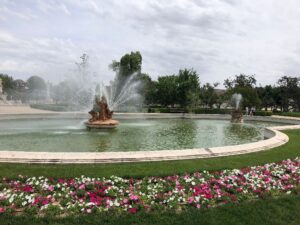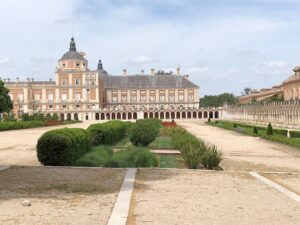I wouldn’t want my readers to think that all I did during my trip to Spain was to go after my father’s footsteps during the Spanish Civil War. I also had lots of family time and fun with friends. A memorable outing was a visit to the Aranjuez Palace with my childhood friend Inés Alberdi.
Inés isn’t just any old friend. Not only we attended school together, Nuestra Señora del Loreto, the strict French Ursuline nuns, but given our last names —of course we sat in alphabetical order— we shared the same desk. We reconnected when she visited Philadelphia on an Eisenhower Fellowship and grew closer the year she was the Executive Director of UNIFEM at the United Nations in New York City. Inés has enjoyed a brilliant career as a sociologist, which culminated with The National Sociology Prize in 2021.
Now we see each other on every occasion and talk endlessly about political and social events, even if months or even years —thanks to Covid— have gone by. This time, on a beautiful May Sunday, we visited the Gardens of the Aranjuez Palace together.
The Royal Palace of Aranjuez was built as a country residence for hunting in the countryside about half an hour from Madrid. The construction was started during Carlos V government in the sixteenth century, continued by Felipe II and finished by Carlos III in the eighteenth century. In addition to the enormous Renaissance buildings, the palace is known for its magnificent botanical gardens, with over four hundred species, surrounded by the Tajo and Jarama rivers. The entire complex was named a UNESCO World Heritage Site in 2001.
But nothing compares to the fountains of the Gardens of the Aranjuez Palace, even for Madrid visitors used to a city full of fountains like Cibeles and Neptuno in the Paseo del  Prado. Take the Fountain of Mariblanca at the entrance of the gardens, with the goddess Venus on top, holding a water pitcher (not her usual iconography). The hexagonal pedestal underneath is adorned with four elements of nature: water, represented by the frogs; fire by the salamanders; the face of the blowing suns symbolizes air and two lions that embrace the globe represent earth. The other lion embracing a castle could be a symbol of royalty.
Prado. Take the Fountain of Mariblanca at the entrance of the gardens, with the goddess Venus on top, holding a water pitcher (not her usual iconography). The hexagonal pedestal underneath is adorned with four elements of nature: water, represented by the frogs; fire by the salamanders; the face of the blowing suns symbolizes air and two lions that embrace the globe represent earth. The other lion embracing a castle could be a symbol of royalty.
Another monumental fountain is Apollo made from Carrara marble, standing on top of stair-like rocks, holding the symbolic lyre and arrows by his feet. He is flanked by Corinthian columns topped with swans and two shrines that hold small cupids inside and baskets with marine animals propped by children above The artichokes between the columns could symbolize the fertility of the gardens in Aranjuez. On the day we visited not all the fountains were turned on, creating a melancholic feeling. Also, I was thinking of my late husband Peter when he played El Concierto de Aranjuez by Joaquín Rodrigo with the Philadelphia Orchestra. He would have loved visiting these gardens!
small cupids inside and baskets with marine animals propped by children above The artichokes between the columns could symbolize the fertility of the gardens in Aranjuez. On the day we visited not all the fountains were turned on, creating a melancholic feeling. Also, I was thinking of my late husband Peter when he played El Concierto de Aranjuez by Joaquín Rodrigo with the Philadelphia Orchestra. He would have loved visiting these gardens!
A beautiful fountain is Narcissus as a young man made from painted lead, with hunting elements on his back and a dog by his  feet. The peacock represents his arrogance. The four strong, masculine figures symbolize strength and hold Narcissus, who was not a god and could die due to his egotism flaw. On the sides there are two amphoras with his hunting trophies. There are many more mythological figures represented in fountains and sculptures throughout the gardens: strong Hercules, representing the Spanish
feet. The peacock represents his arrogance. The four strong, masculine figures symbolize strength and hold Narcissus, who was not a god and could die due to his egotism flaw. On the sides there are two amphoras with his hunting trophies. There are many more mythological figures represented in fountains and sculptures throughout the gardens: strong Hercules, representing the Spanish royalty; beautiful Ceres, with a cornucopia; Bacchus, sitting on a wine barrel; the Nereids frolicking by the sea; Diana, holding her bow and arrow…
royalty; beautiful Ceres, with a cornucopia; Bacchus, sitting on a wine barrel; the Nereids frolicking by the sea; Diana, holding her bow and arrow…
The two rivers meander around the endless grounds. Peacocks stroll undeterred and geese gather in the waterfalls unimpressed by all the spectacular sculptures. In the spring, the typical dessert in Aranjuez is wild strawberries and cream; Inés and I shared them gladly as two good school friends would.


Que bien lo cuentas. Un recuerdo estupendo
Bss
Sí, Inés, fue un día delicioso…
Concha
Thank you for the tour through the Palace Gardens.
Narcissus, my favorite of course, seems to be too far from the water to see his reflection.
XXOO
Alan
True, he would need to get down in the fountain with the rest of us mortals.
Thanks for being such a faithful reader!
Love, Concha
Thank you for the beautiful pictures of fountains. A joy to behold, Diane.
Thanks so much, Concha
Thanks for sharing. One of my closest friends also was my desk mate. Amazing fountains!
L B Pilling
There is nothing like old school friends, Lucille.
Concha
Well done Concha. Your descriptions make me want to visit Spain again.
Take care,
Herman
Thanks, Herman. I’m homesick already and I just got back…